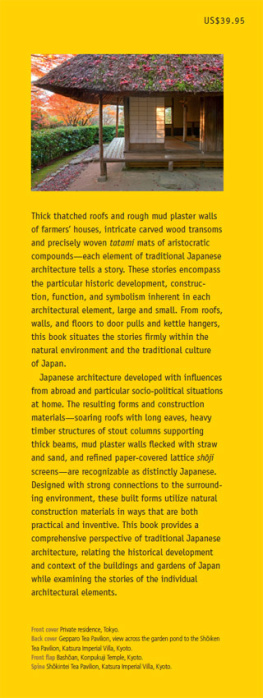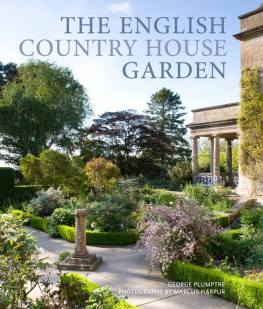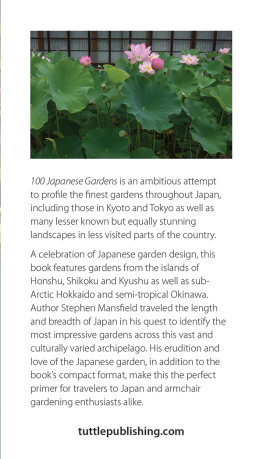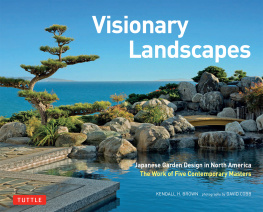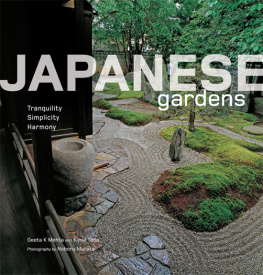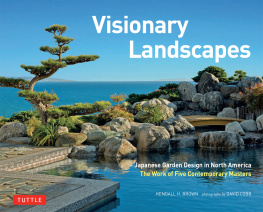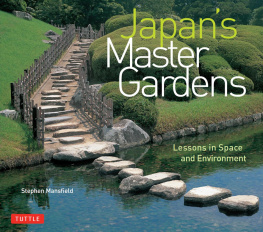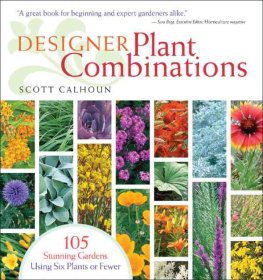ACKNOWLEDGMENTS
This book grew from the teaching, inspiration, support, assistance, and encouragement of many people over many yearsthey are too numerous to thank individually, but I am deeply grateful to all. For those who walked with me on the nobedan and stepping-stones of their gardens or sat with me on the engawa to observe the changing shadows when the breeze rustled a branch of the maple tree, I thank them for sharing their knowledge and insight. I am indebted to Shunmyo Masuno for his great teachings and inspiring designs and to Masuno Yoshihiko and Narikawa Keiichi of Japan Landscape Consultants for their steadfast assistance. Many thanks go to those who planted seeds and trimmed branches: Eric Oey, Cal Barksdale, June Chong and Chan Sow Yun from Tuttle Publishing; and Hannah Vaughan. But most of all, the book would not have developed without my tateishi , Murakami Takayuki.
The author gratefully acknowledges the following photo credits: front flap Japanese Zen Garden construction, 1995, Canadian Museum of Civilization, photo Steven Darby, S2000-3621; page , bottom Japanese Zen Garden, 1996, Canadian Museum of Civilization, photo Steven Darby, K2000-1231.
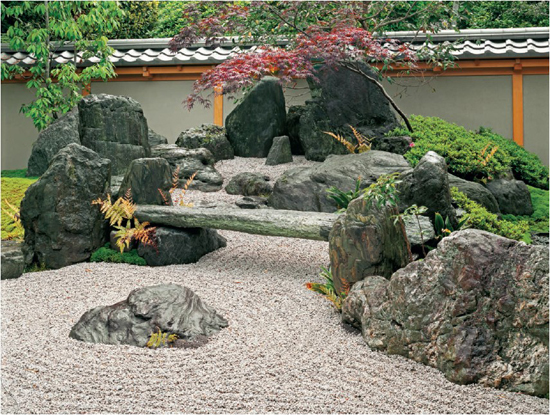
Raked gravel, rocks, and plantings combine in a scene of a river flowing from a waterfall in the karesansui (dry) Rymontei garden at Gionji temple.
BIBLIOGRAPHY
Baroni, Helen Josephine. The Illustrated Encyclopedia of Zen Buddhism . New York: Rosen Publishing Group, 2002.
Berthier, Franois. The Dry Landscape Garden: Reading Zen in the Rocks . Chicago: University of Chicago Press, 2000.
Bring, Mitchell, and Jesse Wayembaugh. Japanese Gardens: Design and Meaning . New York: McGraw-Hill, 1981.
Brooklyn Botanic Garden Record: Japanese Gardens: Plants and Gardens . New York: Brooklyn Botanic Garden, 1990.
Callicott, J. Baird, and Roger T. Ames (eds.). Nature in Asian Traditions of Thought: Essays in Environmental Philosophy . Albany: State University of New York Press, 1989.
Carter, Robert E. The Japanese Arts and Self-Cultivation . Albany: State University of New York Press, 2008.
Conder, Josiah. Landscape Gardening in Japan . New York: Dover Publications, 1964 (from second revised edition of 1912, orig. 1893).
Dale, Peter N. The Myth of Japanese Uniqueness . New York: St. Martins Press, 1986.
Fukuda Kazuhiko. Japanese Stone Gardens: How to Make and Enjoy Them . Rutland, Vt., and Tokyo: Charles E. Tuttle, 1970.
Harada Jiro. Japanese Gardens . Boston: Charles T. Branford Company, 1956.
Hisamatsu Shinichi (trans. Tokiwa Gishin). Zen and the Fine Arts . Tokyo: Kodansha International Ltd., 1971.
Keane, Marc P. Japanese Garden Design . Rutland, Vt., and Tokyo: Charles E. Tuttle, 1996.
Kuck, Loraine. The World of the Japanese Landscape Garden: From Chinese Origins to Modern Landscape Art . New York and Tokyo: Weatherhill, 1989, first published 1968.
Locher, Mira. Traditional Japanese Architecture: An Exploration of Elements and Forms . Rutland, Vt., and Tokyo: Tuttle Publishing, 2010.
Main, Alison, and Newell Platten. The Lure of the Japanese Garden . New York and London: W.W. Norton & Company, 2002.
Masuno Shunmyo. Kono nihonjin ga sugoi rashii ( This Japanese Person Seems to Be Amazing ) . TV Tokyo, GB Production. December 17, 2010, television.
Masuno Shunmyo. Inside Japanese Gardens: From Basics to Planning, Management and Improvement . Translated by Aaron Baldwin. Osaka: The Commemorative Foundation for the International Garden and Greenery Exposition, 1990. First published 2003 as Nihon teien no kokoroe: kiso chishiki kara keikaku, kanri, kaishu made .
. Zen Gardens vol. II: The World of Landscapes by Shunmyo Masuno ( Zen no niwa II: Masuno Shunmyo sakuhinshu 2004-2009 ) . Tokyo: Mainichi Shinbunsha, 2003.
Masuno Shunmyo and Tabata Minao. Zen Gardens: The World of Shunmyo Masuno ( Zen no niwa: Masuno Shunmyo no sekai ) . Tokyo: Mainichi Shinbunsha, 2010.
Mehta, Geeta K., and Tada Kimie. Japanese Gardens: Tranquility Simplicity Harmony . Rutland, Vt., Tokyo, and Singapore; Tuttle Publishing, 2008.
Nitschke, Gnter. Japanese Gardens: Right Angle and Natural Form . Cologne: Benedikt Taschen Verlag GmbH, 1993.
Process: Architecture Special Issue No. 7, Landscapes in the Spirit of Zen, A Collection of the Work of Shunmyo Masuno . Tokyo: Process Architecture Company Ltd., 1995.
Richie, Donald. A Tractate on Japanese Aesthetics . Berkeley: Stone Bridge Press, 2007.
Saito Katsuo. Designing Japanese Gardens . Translated by Hiki Shinjiro. Tokyo: Gihodo Co., Ltd., 1961.
Saito Katsuo and Wada Sadaji. Magic of Trees and Stones: Secrets of Japanese Gardening . Translated by Richard L. Gage. New York and Tokyo: JPT Book Company, 1964.
Schaarschmidt-Richter, Irmtraud, and Mori Osamu. Japanese Gardens . Translated by Janet Seligman. New York: William Morrow and Company, Inc., 1979.
Shunmyo Masuno: Seigen-tei. In Kunst for Menneskelige Basalbehov: Bygg for Biologiske Basalfag ved Universitetet i Bergen ( Art for Basic Human Needs: The Building for Basic Biological Research at the University of Bergen ) , http://www.koro.no/filestore/BBB_kat_web. pdf, 1227.
Slawson, David A. Secret Teachings in the Art of Japanese Gardens: Design Principles and Aesthetic Values . Tokyo: Kodansha, 1987.
Suzuki, Daisetz T. Zen and Japanese Culture . Princeton, N.J.: Princeton University Press, 1959.
Takei, Jiro, and Mark P. Keane. Sakuteiki: Visions of the Japanese Garden , North Clarendon, Vt.: Tuttle Publishing, 2008.
Trulove, James Grayson, ed. Ten Landscapes: Shunmyo Masuno . Rockport, Mass.: Rockport Publishers, Inc., 1999.
Weiss, Allen S. On the Circulation of Metaphors in the Zen Garden. AA files no. 60, 2010, 8993.

Three carefully arranged rocks in a bed of raked gravel in the Chsetsuko courtyard garden at the Ginrins Rykan condense the essence of the universe into a few simple elements.
TRADITIONAL ZEN GARDENS
IN THE 21st CENTURY

A beautifully shaped pine tree growing on an island of moss is balanced with a rough rock rising from the pond in the garden at the Kyoto Reception Hall.
In Japanese culture, writes Shunmyo Masuno, rather than emphasizing the form of something itself, more importance is placed on the feeling of the invisible things that come with it: restrained elegance, delicate beauty, elegant simplicity and rusticity. The invocation of these qualities is deeply rooted in Japanese aesthetics and is a central tenet in the traditional arts of calligraphy, flower arrangement, tea ceremony, and garden design, among others.
In his gardens, Masuno creates these feelings by emphasizing the design of the atmosphere of a place, rather than the shape of a space or object. Of course, it is possible to achieve this with contemporary materials and compositions as well as long-established elements and arrangements, but in many of his gardens Masuno makes a conscious choice to utilize traditional materials and compositional devicesto create a traditional garden. But what is a traditional Japanese garden in the twenty-first centuryand what is its role in contemporary life?


